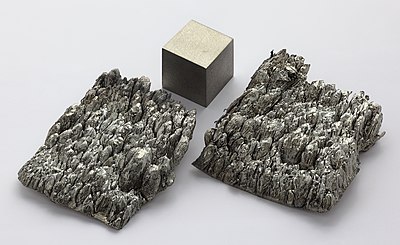Scandium is a chemical element with the symbol Sc and atomic number 21.

Here are some properties of scandium:
Physical properties of scandium
- Appearance: Scandium is a silvery-white metal.
- Density: The density of scandium is about 2.99 grams per cubic centimeter.
- Melting Point: Scandium has a relatively high melting point of 1541 degrees Celsius (2806 degrees Fahrenheit).
- Boiling Point: The boiling point of scandium is 2836 degrees Celsius (5137 degrees Fahrenheit).
- State at Room Temperature: Scandium is a solid at room temperature
Chemical properties of scandium
- Reactivity: Scandium is a moderately reactive metal.
- Oxidation States: Scandium primarily exhibits a +3 oxidation state, meaning it tends to lose three electrons to form ions (Sc3+).
- Electronegativity: Scandium has an electronegativity of 1.36 on the Pauling scale, indicating a moderate affinity for electrons.
- Stability: Scandium is stable in dry air but reacts slowly with moist air. It forms a protective oxide layer on its surface, which prevents further oxidation.
Atomic and Electronic Properties of scandium
- Atomic Number: Scandium has an atomic number of 21, indicating it has 21 protons in its nucleus.
- Atomic Weight: The atomic weight of scandium is approximately 44.96 atomic mass units.
- Electron Configuration: The electron configuration of scandium is [Ar] 3d1 4s2, meaning it has one electron in the 3d orbital and two electrons in the 4s orbital.
Occurrence and Uses
- Abundance: Scandium is relatively rare in the Earth’s crust, occurring in trace amounts in various minerals.
- Alloying Agent: Scandium is often used as an alloying element, particularly in aluminum alloys. It improves the strength, corrosion resistance, and weldability of aluminum, making it useful in aerospace and sports equipment industries.
- Solid Oxide Fuel Cells: Scandium oxide (scandia) is used as an electrolyte material in solid oxide fuel cells due to its high oxygen-ion conductivity.
- Lighting and Display Technologies: Scandium iodide is employed in high-intensity discharge lamps and as a component in fluorescent lamps to produce a high-quality white light.
- Research and Scientific Applications: Scandium has applications in various research fields, such as catalysis, isotopic labeling in nuclear medicine, and the production of positron emission tomography (PET) imaging agents.
It’s important to note that while scandium exhibits these properties, some details may vary depending on specific conditions and isotopes.